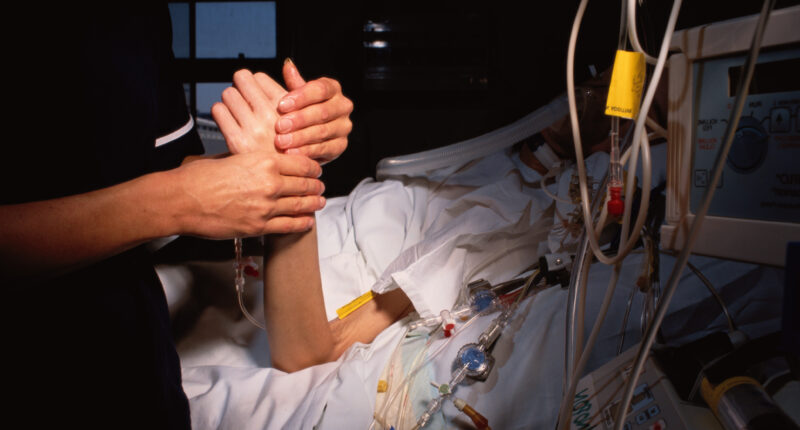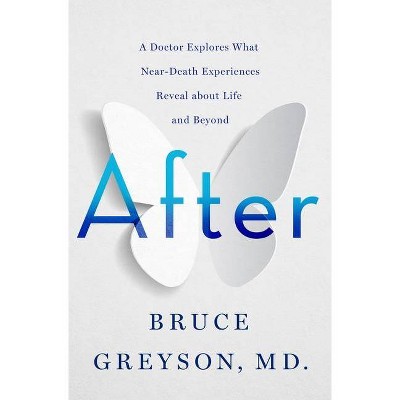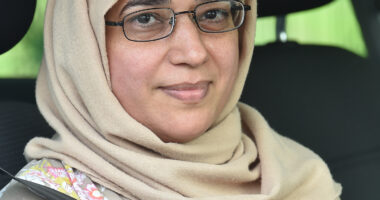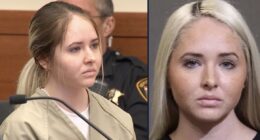A NEAR-death experience expert who has been studying the mysterious phenomena for the last 50 years has revealed to The US Sun what he believes happens to us when we die.
Dr. Bruce Greyson, a professor of psychiatry at the University of Virginia, began investigating near-death experiences (NDEs) in the mid-1970s after a “frightening” exchange he shared with one of his patients.
Greyson had been eating pasta in a hospital cafeteria when one evening his beeper went off to alert him to a patient, named Holly, who had been raced into the ER after attempting to kill herself by overdosing on prescription pills.
In a haste, Greyson spilled a drop of spaghetti sauce on his tie as he stood up. But, with no time to change, he put on his lab coat and raced to Holly’s side where he found her completely incapacitated on a hospital gurney.
“I couldn’t wake her up,” Greyson recounted to The US Sun, “So I went to talk with her roommate in another room down the hallway to find out what had happened with her.”
When Greyson returned to Holly she was still unconscious, though her condition had stabilized and she was breathing slowly, but steadily again.
Holly was held in the hospital overnight and finally came around the following morning. Dr. Greyson went in to see her, but, as he began introducing himself, Holly, who was still stirring, interrupted him, saying: “I know who you are, I remember you from last night.”
Confused by what she meant, Dr. Greyson told Holly that he didn’t know she could see him, remarking: “I thought you were out cold.”
“Then she told me, ‘No, not in my room. I saw you talking to my roommate down the hall,'” Greyson remembered.
Suddenly Holly opened her eyes, looked at Dr. Greyson and added: “You were wearing a striped tie that had a red stain on it.”
Greyson said he stood there stunned, the hairs on the back of his neck standing on end, as Holly proceeded to recount his conversation with her roommate at great length, and with great accuracy.
“That stopped me in my tracks right there,” Greyson said, five decades on. “Everything she was saying was completely correct. It just blew my mind.
“The only way that could have happened was that she had left her body and come down the hall with me. And as far as I could tell at the time, you are your body – how can you leave it?”
Greyson tried to put the incident out of his mind, reassuring himself that someone was likely playing a prank on him.
But over the next few years, he kept hearing about similar stories involving patients who claimed to have left their bodies during a near-death event, reminding him of the strange interaction he shared with Holly.
Then in 1975, Raymond Moody released his seminal book Life After Life, in which he interviewed 150 people who had undergone a near-death experience, coining the term NDE for the first time.
“When Raymond Moody published that book … I realized for the first time that these just weren’t a few psychiatric patients telling these stories, NDEs were happening to normal people all over the world,” he said.
“Being a scientist I just couldn’t understand this – and 50 years later I’m still trying to understand them.”
MYSTERIOUS EXPERIENCES
Since his chance meeting with Holly, Dr. Greyson has conducted thousands of interviews with people who claimed to have an NDE, published hundreds of papers, and co-founded the International Association of Near-Death Studies.
Because near-death experiences happen with extremely limited warning they’re almost impossible to test.
Written accounts of NDEs date back to at least the middle ages but there is no widely accepted definition of what an NDE is.
Typically, though, the term refers to the mystical, profound experiences that people report having when they are on the verge of death.
Statistics show they’re most common in patients who survive severe head traumas or cardiac arrest.
In the US, an estimated 9 million people have reported having an NDE, a 2011 study in Annals of the New York Academy of Sciences found.
Worldwide, it’s believed that somewhere between 10% and 20% of people who come close to death report having an NDE – accounting for around 5% of the population.
Such individuals – or NDErs, as they’re collectively known – often report being deeply changed afterward, whether that be a newfound appreciation for life, a diminished fear of death, or a spiritual awakening.
The field of science remains divided on the matter. Some attribute NDEs to hallucinatory flights of imagination, the final gasping breaths of a dying brain.
However, others, such as Dr. Greyson, believe NDEs may help to unlock the mysteries of human consciousness – and the possibility that it may continue to live on even after our bodies die.
THE LIFE REVIEW
While no two NDEs are identical, during his decades of study Dr. Greyson has identified a number of common elements experienced by those who’ve reported having one.
One of the most common things experienced during an NDE is the sensation of leaving your body.
According to Greyson, like Holly, around 80 percent of NDErs report leaving behind their physical body in some capacity during a near-death event.
Another well-known feature – affecting about one in three NDErs – is what’s know as the “life review”, in which a person’s life flashes before their eyes.
Dr. Greyson pointed The US Sun to a famous “life review” case from the 1890s involving the famed Swiss geology professor, Albert von St Gallen Heim.
In a paper published by the Swiss Alpine Club in 1892, Heim said he had fallen while climbing in the Alps years earlier, and, as he fell, he repeatedly crashed against the rocks.
While Heim ended up landing in a snowdrift and surviving, during his free-fall he had time to think about everything that had happened in his life, in immense detail and with great clarity, in just the few seconds it took for him to hit the ground.
He also said he felt no pain, describing his violent descent as tranquil and calm.
“What I felt in five to ten seconds could not be described in ten times that length of time,” Heim wrote in 1892. “All my thoughts and ideas were coherent and very clear, and in no way susceptible, as are dreams, to obliteration.
“I saw my whole past life take place in many images, as though on a stage at some distance from me. I saw myself as the chief character in the performance. Everything was transfigured as though by a heavenly light and everything was beautiful without grief, without anxiety and without pain.
“The memory of very tragic experiences I had had was clear but not saddening. I felt no conflict or strife; conflict had been transmuted into love.”
ALL IS ONE
According to Greyson’s research, NDErs’ thoughts get clearer and faster as they approach death, with around two-thirds reporting “extraordinarily vivid sensations”, including seeing incredibly bright and unique colors, and even experiencing clearer hearing and unique sounds.
While in the midst of a life review, some NDErs also re-experience moments from their lives through the eyes of other people.
Dr. Greyson interviewed one man in his 30s who had been working on his truck when a jack failed and the vehicle came crashing down onto his chest.
On the brink of death, the man experienced an NDE, living his life in full up to the point of the truck falling on top of him.
“During one incident he mentioned he was a teenager, he was driving his truck when a man stepped out in front of him and he almost hit him,” Dr. Greyson said.
“So the teen rolled down his window and started yelling at the man. The man was intoxicated and tried to grab him by the throat, so he got out of the truck and started beating the drunk man with his fists.
“But during his life review, he relieved all the sensations of what he was feeling in that moment – the adrenaline rush, the rage, and so forth – but also felt and saw everything through the drunk man’s eyes: feeling the 32 blows to his face, his nose flowing with blood, his teeth going through his lip, and the shame of being beaten by a teenager.”
Greyson continued: “After the near-death experience, he came away with a strong feeling that we’re all the same, that I’m not separated from this other guy, and that whatever I did to him I did to myself.
“A lot of the people who had these kinds of experiences report coming away realizing that the golden rule ‘do unto others as you’d have them do to you’ is not a guideline we’re supposed to follow – it’s a law of the universe.”
This sense of oneness, Greyson says, is often likened by NDErs to a wave in the ocean. Our life is the wave, seemingly distinct from the rest of the ocean, but after a while it ceases to be a distinct wave and fades back into the blue again.
“We’re all part of the same thing, like a wave” Greyson says. “For the time being we have a distinct identity but it’s not permanent and it doesn’t last – we’re the same as every other wave and we merge with one another.”
SEEING THE DECEASED
Around two-thirds of NDErs also report meeting or seeing another person – typically a deceased loved one – during what they believe at the time to be their final throes of life.
But strangely there have been a number of cases in which an NDEr has met a recently deceased person who was not yet known to have died.
Dr. Greyson interviewed a South African man named Jack Bybee who nearly died from pneumonia in 1972. After going into respiratory arrest, he had to be resuscitated and had an NDE.
During his near-death event, he saw one of the nurses who had been taking care of him for several weeks, named Anita, who had left for a long weekend days earlier.
Anita told Bybee that he must “go back” and tell her parents that she was “sorry she wrecked the red MGB.”
He eventually recovered and told another nurse that he’d seen Anita in his dream and recounted what she said to him.
The nurse ran out of the room in tears. As it would turn out, Anita had been given a red MGB for her birthday. She had gone away for the weekend when she lost control of the car, crashed into a telephone pole and died.
The fatal wreck happened just a few hours before his NDE when Bybee was “dead”, meaning he’d have had no way to have known of her fate.
“We don’t have a medical explanation for NDEs, but they suggest that these deceased people are still functioning in some way,” Greyson said.
“Now most of them are people who have just recently died, so that suggests they can survive after the body dies for some time.
“I don’t know whether it means eternal life, but we don’t have a naturalistic materialistic explanation for this.”
DEBUNKING THEORIES
Dr. Greyson, 75, said it’s unlikely the mystery of NDEs will be solved in his lifetime but asserted that they’re unequivocally real.
Though he cannot answer what causes them, Greyson has been able to rule out some things that do not trigger them.
For instance, some experts have suggested that NDEs might be the byproduct of the powerful drugs typically given to patients who are dying, but Greyson’s research found that those administered drugs actually experienced fewer NDEs.
Other researchers have suggested that NDEs are caused by “electrical activity” in the brain, similar to the kind that causes epileptic seizures. However, analysis of electroencephalograms of people on life support showed that the brain’s electrical activity stops even before the heart does, according to Greyson.
“We don’t know what causes NDEs, but the evidence certainly points towards the idea that potentially the mind and brain can act independently from one another,” he said.
“We’re taught in medical school that the mind is what the brain does and that all our thoughts and perceptions and so forth are all created by the brain. And that seems to be true. When you get intoxicated or if you’re hit in the head, that affects your thinking.
“And yet in extreme circumstances, like near-death experiences, when a brain is shutting down, the mind seems to be functioning without it – and a lot better without it.”
Greyson said an NDE is not the only example of the mind potentially functioning separately from the brain.
He pointed to a phenomenon known as terminal lucidity, which someone times occurs in Alzheimer’s patients towards the end of their lives.
“Terminal lucidity happens when people who haven’t been able to recognize their family or communicate for months are able to become completely lucid again, recognizing people, holding conversations, and then within a few hours they usually die.
“There’s no medical explanation for how this could be, yet it still happens,” he said.
LIFE AFTER DEATH?
Dr. Greyson suggests that the brain may not actually create the mind or consciousness, rather that it serves as a filter that allows certain states of basic consciousness.
He explained: “It’s more like the brain is receiving and interpreting the mind, kind of like how a television set will receive signals from outside and then flip to the channel you want to watch and translate that for us, so you can see the images in color and sound.
“Now this makes sense because the brain evolved as a physical worker to help us survive in the world,” Greyson continued. “So it makes sense that the brain would filter out irrelevant stimuli and just let in those stimuli that are relevant to survival, like finding food.
“So if your mind is communicating with deceased loved ones and with deities, that doesn’t help you survive in the physical world. So the brain would normally filter those things down and just let in the important stuff.
“But when the brain is shutting down, that filtering function stops and all this other stuff comes flooding in.”
Dr. Greyson said he was raised in a materialistic scientific household where he never held any spiritual or religious beliefs.
However, over the half-a-century he’s spent investigating NDEs, Greyson said his own beliefs about life and death have changed dramatically.


“Before I started this work, it just didn’t make sense to me that you could live on after death, because when your body dies, of course, you do.
” But I’ve seen so much evidence now strongly suggesting that something about us – our consciousness – does survive so I think that’s what happens.
“I don’t think I have any conception of what an afterlife is like if there is one,” Greyson added.
“But I do think there is one.”
Dr. Greyson released a book called After in 2021, compiling his years of research into NDEs. It’s available for purchase on his website.
We pay for your stories!
Do you have a story for The US Sun team?















